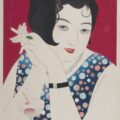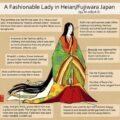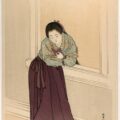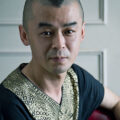Japan House kimono colour exhibition
May 19, 2019
Living Colours – Kasane, the Language of Japanese Colour Combinations is the Japan House kimono colour exhibition that everyone’s been talking about.
Japan House opened with a flourish last year, and is intended as a cultural centre and shop, displaying the best of Japan’s products and crafts on the ground floor, with a relevant exhibition downstairs in the gallery space and a restaurant upstairs.
Not to be confused with the Japan Centre in Piccadilly, with its riotously packaged noodles and kawaii Hello Kitty lunchboxes, each item in the shop in Japan House is refined of packaging and as reverently laid out as a museum piece. This includes every day things like soya sauce (though at a vastly inflated price, it has to be said) all the way up to delicately crafted handmade tea caddies made from glowing cherry tree bark, which cost hundreds.
The building itself is carefully designed and lit, and evokes an instant atmosphere of calm. The staff are universally friendly and enthusiastic. It’s a nice place to drop into, away from the business of Kensington High Street.
First of all, a window display in shades of pink, red and green draws you in. The first part of the Japan House kimono colour exhibition is on the ground floor as you enter, in a little display area all to itself. This relates to the language of flowers. Much like the English Victorian tradition of sending flowers as tokens of love or friendship, the Japanese have the same idea. Dating back to the Heian period, (794 to 1185) the Hanakotoba is the Japanese form of the language of flowers. Each plant was given codes and passwords. These are meant to convey emotion and communicate directly to the recipient or viewer without needing the use of words.
Beautifully dramatic Japan House kimono colour exhibition
In the Japan House kimono colour exhibition, beautifully constructed origami flowers represent the fresh flowers, along with folded sheets of washi paper in corresponding colours. Sometimes the fresh or pressed flower was sent enfolded in washi paper on which a poem was written. Sometimes a flower was sent alone: everything from a single delicate bloom to an extravagant branch of a rare mountain tree was sent to make the point. Sometimes just a sheet of beautiful paper in the appropriate colour went with the messenger.
One hopes that the recipient wasn’t left puzzling over the exact message without wanting to say that they didn’t get it! The idea was to be witty, refined, and romantic in an original way. The Heian court in particular prized clever and witty people who could appreciate and show beauty, so excellent poetry skills were as important as a good way with a sword for a man who wanted to court a lady.
Heian ladies
In turn, Heian ladies also sent poetry and love tokens, but also communicated through their clothes. This was mainly because they were completely forbidden from showing their face or actually any part of themselves to any man who wasn’t a close relative, husband or servant. So they delicately flouted this rule by exposing only a trailing sleeve or hem when they went out in closed carriages.
Actually, it was not just one hem, but a graduated series of hems, layers of the kimono and undergarments. This system was called jūnihitoe, the twelve layer robe but in fact, consisted of up to twenty layers. There is a beautiful book in the exhibition, hand painted and from the time period which records only the carriages of the noble class, a different one on each page. Not only the carriage itself is recorded, with the details of carving, but the clothing which flutters from the back, with a glimpse of the pattern of each layer.
Details like this lovely book are included to explain the story, but the main effect of the exhibition is the dramatic bolts of silk which swoop from the ceiling in the layers of colour decreed by season and status. As explained in my article here, there were strict codes of colour and pattern according to the weather, the wearer’s age, and who they were. Within this, the wearer also had to find an artistic interpretation. There were guidebooks printed on this theme, one of which is here in the exhibition.
Japan House kimono colour exhibition – The colours of the seasons
This show concentrates on the colours involved, and not the patterns or the different weights or weaves of silks. In actuality, there would have been a fine, soft silk nearest the skin, and heavier weights going outwards. Different patterns would have been woven into the jacquard of the heavier silk, with meaningful embroidery motifs on the outside, most visible layer. The silk here is all the same weight, quite a heavy jacquard. This means that the layers are opaque and it misses out on the subtlety of the colours showing through each other.
That being said, the effect is gorgeous. Starting with spring, the drapes of colour are shown against pillars. You progress to summer and then turning about, find autumn and winter in the reverse, so can go back down the room until it has all reached full circle on the first pillar again. The swoops of silk are not encased in any way so you can get close to the vibrant fabrics, but if you want to touch them, samples are held near the front for handling.
Towards the centre are some artefacts about the dyeing process. These fabrics have all been dyed using natural materials, and a fascinating display shows the original leaf, twig or flower that was used, a hank of thread showing the colour that can be achieved, and some information on the stability or otherwise of the final dye.
Fascinating and lovely, the exhibition is free and on until the 19th May. Catch it while you can!















